seats Citroen JUMPY 2012 2.G User Guide
[x] Cancel search | Manufacturer: CITROEN, Model Year: 2012, Model line: JUMPY, Model: Citroen JUMPY 2012 2.GPages: 268, PDF Size: 9.71 MB
Page 93 of 268
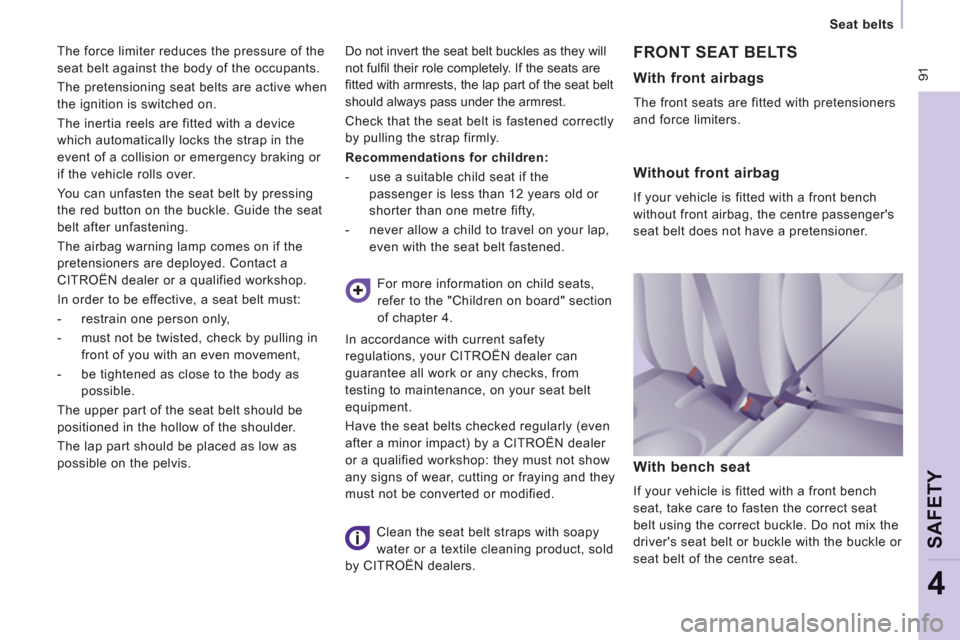
91
Seat belts
SAFETY
4
The force limiter reduces the pressure of the
seat belt against the body of the occupants.
The pretensioning seat belts are active when
the ignition is switched on.
The inertia reels are fitted with a device
which automatically locks the strap in the
event of a collision or emergency braking or
if the vehicle rolls over.
You can unfasten the seat belt by pressing
the red button on the buckle. Guide the seat
belt after unfastening.
The airbag warning lamp comes on if the
pretensioners are deployed. Contact a
CITROËN dealer or a qualified workshop.
In order to be effective, a seat belt must:
- restrain one person only,
- must not be twisted, check by pulling in
front of you with an even movement,
- be tightened as close to the body as
possible.
The upper part of the seat belt should be
positioned in the hollow of the shoulder.
The lap part should be placed as low as
possible on the pelvis.
Recommendations for children:
- use a suitable child seat if the
passenger is less than 12 years old or
shorter than one metre fifty,
- never allow a child to travel on your lap,
even with the seat belt fastened.
FRONT SEAT BELTS
For more information on child seats,
refer to the "Children on board" section
of chapter 4.
In accordance with current safety
regulations, your CITROËN dealer can
guarantee all work or any checks, from
testing to maintenance, on your seat belt
equipment.
Have the seat belts checked regularly (even
after a minor impact) by a CITROËN dealer
or a qualified workshop: they must not show
any signs of wear, cutting or fraying and they
must not be converted or modified.
Clean the seat belt straps with soapy
water or a textile cleaning product, sold
by CITROËN dealers.
With front airbags
The front seats are fitted with pretensioners
and force limiters.
Without front airbag
If your vehicle is fitted with a front bench
without front airbag, the centre passenger's
seat belt does not have a pretensioner.
With bench seat
If your vehicle is fitted with a front bench
seat, take care to fasten the correct seat
belt using the correct buckle. Do not mix the
driver's seat belt or buckle with the buckle or
seat belt of the centre seat. Do not invert the seat belt buckles as they will
not fulfi l their role completely. If the seats are
fi tted with armrests, the lap part of the seat belt
should always pass under the armrest.
Check that the seat belt is fastened correctly
by pulling the strap firmly.
Page 96 of 268
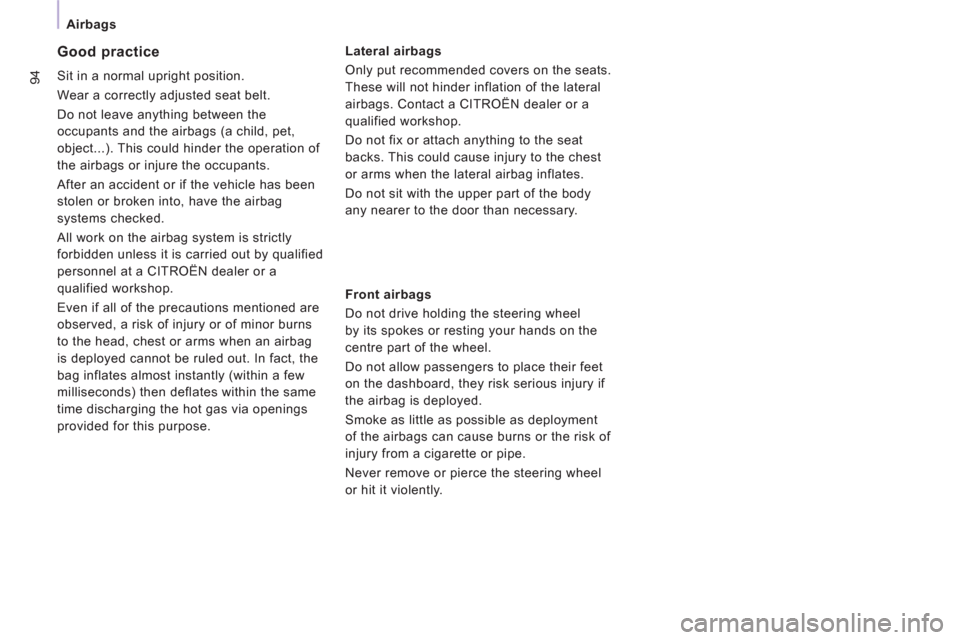
94
Airbags
Good practice
Sit in a normal upright position.
Wear a correctly adjusted seat belt.
Do not leave anything between the
occupants and the airbags (a child, pet,
object...). This could hinder the operation of
the airbags or injure the occupants.
After an accident or if the vehicle has been
stolen or broken into, have the airbag
systems checked.
All work on the airbag system is strictly
forbidden unless it is carried out by qualified
personnel at a CITROËN dealer or a
qualified workshop.
Even if all of the precautions mentioned are
observed, a risk of injury or of minor burns
to the head, chest or arms when an airbag
is deployed cannot be ruled out. In fact, the
bag inflates almost instantly (within a few
milliseconds) then deflates within the same
time discharging the hot gas via openings
provided for this purpose.
Lateral airbags
Only put recommended covers on the seats.
These will not hinder inflation of the lateral
airbags. Contact a CITROËN dealer or a
qualified workshop.
Do not fix or attach anything to the seat
backs. This could cause injury to the chest
or arms when the lateral airbag inflates.
Do not sit with the upper part of the body
any nearer to the door than necessary.
Front airbags
Do not drive holding the steering wheel
by its spokes or resting your hands on the
centre part of the wheel.
Do not allow passengers to place their feet
on the dashboard, they risk serious injury if
the airbag is deployed.
Smoke as little as possible as deployment
of the airbags can cause burns or the risk of
injury from a cigarette or pipe.
Never remove or pierce the steering wheel
or hit it violently.
Page 99 of 268

97
Child safety
SAFETY
4
GENERAL POINTS RELATING TO
CHILD SEATS
"Rearwards-facing"
Recommended on the rear seats up to the
age of 2.
When a "rearwards-facing" child seat is
installed on the front passenger seat, it
is essential that the passenger air bag is
deactivated. Otherwise, the child would risk
being seriously injured or killed if the airbag
were to inflate.
"Forwards-facing"
Recommended on the rear seats over the
age of 2.
When a "forwards-facing" child seat is
installed on the front passenger seat, leave
the passenger air bag activated.
CHILD SEAT IN THE FRONT
The rules for carrying children are specific to
each country. Consult the current legislation
in your country.
Please consult the list of seats approved
in your country. The Isofix mountings, the
rear seats, the passenger airbag and the
deactivation of this airbag depend on the
version sold.
Although one of CITROËN's main criteria
when designing your vehicle, the safety of
your children also depends on you.
For maximum safety, please follow these
precautions:
- all children under the age of 12 or less
than one metre fifty tall must travel in
approved child seats suited to their
weight, on seats fitted with a seat belt or
ISOFIX mountings,
- statistically, the safest seats in your
vehicle for the transportation of children
are the rear seats,
- a child weighing less than 9 kg must
travel in the "rearwards-facing" position
both in the front and in the rear,
- the passenger must not travel with a
child on his lap.
Page 100 of 268

98
Child safety
Passenger airbag OFF
Refer to the advice given on the label
present on both sides of the passenger's
sun visor.
To assure the safety of your child, you must deactivate the passenger's front airbag
when you install a child seat in the rearwards facing position on the front passenger's
seat.
Otherwise, there is a risk that the child could be seriously injured or killed if the airbag
were deployed.
The child seats function and the
passenger's airbag deativation function
are common to the entire CITROËN range.
If the passenger's airbag is not deactivated,
the installation of a "rearwards-facing" child
seat in the front is strictly prohibited.
Refer to chapter 4, "Airbags" section.
Page 101 of 268

99
Child safety
SAFETY
4
CHILD SEATS RECOMMENDED BY CITROËN
CITROËN offers a complete range of recommended child seats which are secured using a three point seat belt
:
Group 0+: from birth to 13 kg
L1
"ROMER Baby-Safe Plus"
Installed in the rear-facing position.
Groups 2 and 3: from 15 to 36 kg
L3
"RECARO Start''.
L4
"KLIPPAN Optima"
From the age of 6 years (approximately
22 kg), the booster is used on its own.
L5
"RÖMER KIDFIX"
Can be fixed on the vehicle's ISOFIX mountings.
The child is restrained by the seat belt.
Page 102 of 268

100
Child safety
a: Group 0: from birth to 13 kg. Infant car seats and "car cots" cannot be installed on the front passenger seat.
b: consult the legislation in force in your country before installing your child on this seat.
U: seat suitable for the installation of a child seat secured using a seat belt and universally approved, "rear facing" and/or "forward facing".
INSTALLING CHILD SEATS ATTACHED USING THE SEAT BELT
This table indicates the options for installing child seats secured using a seat belt and universally approved in accordance with the weight of
the child and the seat in the vehicle.
Seat
Weight of the child and indicative age
Under 13 kg
(groups 0 (a) and 0+)
Up to approx 1 year
From 9 to 18 kg
(group 1)
1 to 3 years approx
From 15 to 25 kg
(group 2)
3 to 6 years approx
From 22 to 36 kg
(group 3)
6 to 10 years approx
Row 1 (b)
Individual seat
U
U
U
U
Bench, outer seat
U
U
U
U
Bench,
centre seat
L1
-
L3, L4, L5
L3, L4, L5
Page 103 of 268

10
1
Child safety
SAFETY
4
ADVICE ON CHILD SEATS
The incorrect installation of a child seat in a
vehicle compromises the child's protection in
the event of an accident.
Remember to fasten the seat belts or the
child seat harnesses keeping the slack
in
relation to the child's body to a minimum
,
even for short journeys.
For optimum installation of the "forward
facing" child seat, ensure that the back of
the child seat is in contact with the back of
the vehicle's seat and that the head restraint
does not cause any discomfort.
If the head restraint has to be removed,
ensure that it is stored or attached securely
to prevent it from being thrown around the
vehicle in the event of sharp braking.
Children under the age of 10 must not travel
in the "forward facing" position on the front
passenger seat, unless the rear seats are
already occupied by other children, cannot
be used or are absent.
Deactivate the passenger's airbag when a
"rear facing" child seat is installed on the
front seat.
Otherwise, the child would risk being
seriously injured or killed if the airbag were
to inflate.
As a safety precaution, do not leave:
- one or more children alone and unsupervised
in a vehicle,
- a child or an animal in a vehicle which is
exposed to the sun, with the windows closed,
- the keys within reach of children inside the
vehicle.
To prevent accidental opening of the doors,
use the "Child Lock".
Take care not to open the rear windows by
more than one third.
To protect young children from the rays of
the sun, fit side blinds to the rear windows.
Installing a booster seat
The chest part of the seat belt must be
positioned on the child's shoulder without
touching the neck.
Ensure that the lap part of the seat belt
passes correctly over the child's thighs.
CITROËN recommends the use of a booster
seat which has a back, fitted with a seat belt
guide at shoulder level.
Page 135 of 268
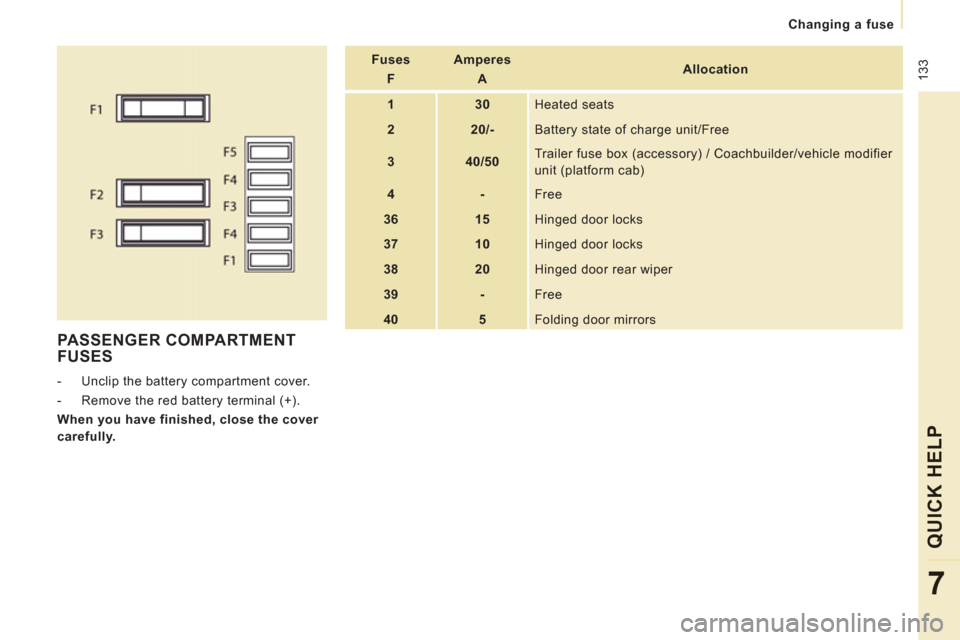
133
Changing a fuse
QUICK HEL
P
7
PASSENGER COMPARTMENT
FUSES
- Unclip the battery compartment cover.
- Remove the red battery terminal (+).
When you have finished, close the cover
carefully.
Fuses
F
Amperes
A
Allocation
1
30
Heated seats
2
20/-
Battery state of charge unit/Free
3
40/50 Trailer fuse box (accessory) / Coachbuilder/vehicle modifier
unit (platform cab)
4
-
Free
36
15
Hinged door locks
37
10
Hinged door locks
38
20
Hinged door rear wiper
39
-
Free
40
5
Folding door mirrors
Page 261 of 268
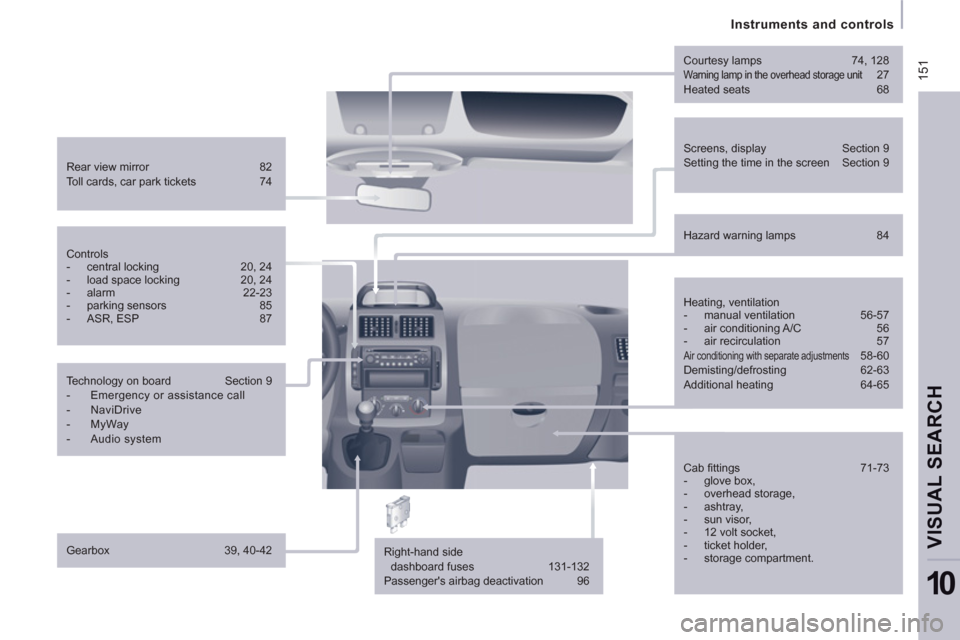
15
1
Instruments and controls
VISUAL SEARCH
10
Screens, display Section 9
Setting the time in the screen Section 9
Rear view mirror 82
Toll cards, car park tickets 74
Courtesy lamps 74, 128
Warning lamp in the overhead storage unit 27
Heated seats 68
Right-hand side
dashboard fuses 131-132
Passenger's airbag deactivation 96
Controls
- central locking 20, 24
- load space locking 20, 24
- alarm 22-23
- parking sensors 85
- ASR, ESP 87
Technology on board Section 9
- Emergency or assistance call
- NaviDrive
- MyWay
- Audio system
Gearbox 39, 40-42
Hazard warning lamps 84
Heating, ventilation
- manual ventilation 56-57
- air conditioning A/C 56
- air recirculation 57
Air conditioning with separate adjustments 58-60
Demisting/defrosting 62-63
Additional heating 64-65
Cab fi ttings 71-73
- glove box,
- overhead storage,
- ashtray,
- sun visor,
- 12 volt socket,
- ticket holder,
- storage compartment.
Page 262 of 268
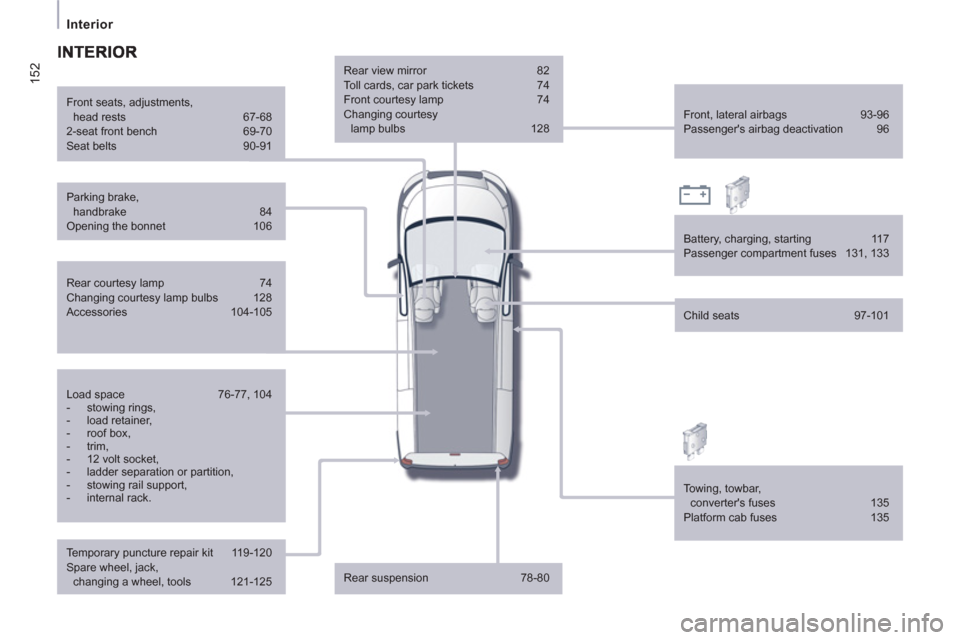
152
Interior
Rear view mirror 82
Toll cards, car park tickets 74
Front courtesy lamp 74
Changing courtesy
lamp bulbs 128
Rear suspension 78-80 Front, lateral airbags 93-96
Passenger's airbag deactivation 96
Parking brake,
handbrake 84
Opening the bonnet 106
Battery, charging, starting 117
Passenger compartment fuses 131, 133 Front seats, adjustments,
head rests 67-68
2-seat front bench 69-70
Seat belts 90-91
Child seats 97-101
Rear courtesy lamp 74
Changing courtesy lamp bulbs 128
Accessories 104-105
Towing, towbar,
converter's fuses 135
Platform cab fuses 135 Load space 76-77, 104
- stowing rings,
- load retainer,
- roof box,
- trim,
- 12 volt socket,
- ladder separation or partition,
- stowing rail support,
- internal rack.
Temporary puncture repair kit 119-120
Spare wheel, jack,
changing a wheel, tools 121-125